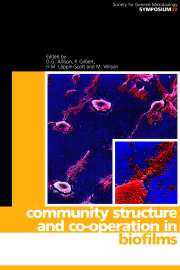Book contents
- Frontmatter
- Contents
- Contributors
- Editors' Preface
- An overview of biofilms as functional communities
- Initial microbial adhesion events: mechanisms and implications
- Physiological events in biofilm formation
- Environmental and genetic factors influencing biofilm structure
- Coaggregation and coadhesion in oral biofilms
- Cohesiveness in biofilm matrix polymers
- Microbial detachment from biofilms
- Modelling and predicting biofilm structure
- Microbial community interactions in biofilms
- Microbial communities: aggregates of individuals or co-ordinated systems
- Gene transfer in biofilms
- Population dynamics in microbial biofilms
- Biodegradation by biofilm communities
- Biofilms and prosthetic devices
- Biofilms: problems of control
- Biofilms in the New Millennium: musings from a peak in Xanadu
- Index
An overview of biofilms as functional communities
Published online by Cambridge University Press: 03 June 2010
- Frontmatter
- Contents
- Contributors
- Editors' Preface
- An overview of biofilms as functional communities
- Initial microbial adhesion events: mechanisms and implications
- Physiological events in biofilm formation
- Environmental and genetic factors influencing biofilm structure
- Coaggregation and coadhesion in oral biofilms
- Cohesiveness in biofilm matrix polymers
- Microbial detachment from biofilms
- Modelling and predicting biofilm structure
- Microbial community interactions in biofilms
- Microbial communities: aggregates of individuals or co-ordinated systems
- Gene transfer in biofilms
- Population dynamics in microbial biofilms
- Biodegradation by biofilm communities
- Biofilms and prosthetic devices
- Biofilms: problems of control
- Biofilms in the New Millennium: musings from a peak in Xanadu
- Index
Summary
INTRODUCTION
A vast number of microbial aggregates fall into this ‘catch-all’ name – biofilm. Whether this unifying term does a great service or the opposite to a core branch of microbiology is open to some doubt – for biofilm is found in almost every environment graced with surfaces, sufficient nutrient and some water. A gentle digital examination of the waste outlet of the average kitchen sink will reveal a certain sliminess which embraces the quintessential soul of a biofilm! That ‘dirt’ which can block car windscreen washer jets is from the same stable. It does not seem necessary to list all possible examples of such structures. They range from growth on the leads of cardiac pacemakers, through biofilm attached to the inner surfaces of water distribution pipes, to the epilithon of rocks in streams and accumulated plaque on the surface of teeth.
There are almost as many definitions of biofilm as there are scientists working in the field or types of the structure itself. Any reasonable definition needs to incorporate the idea of a surface or interface on or at which microbes proliferate; it should also invoke the unifying effect of extracellular polymers which can envelop and probably protect the microbial colonies forming. It might also embrace a sense of community with the implication of emergent properties.
It is worth trying to classify a number of microbial systems that seem to be related to biofilm since they share many of its properties. In fact, members of the whole family of microbial aggregates have more in common than separates them (Table 1).
- Type
- Chapter
- Information
- Community Structure and Co-operation in Biofilms , pp. 1 - 24Publisher: Cambridge University PressPrint publication year: 2000
- 25
- Cited by



